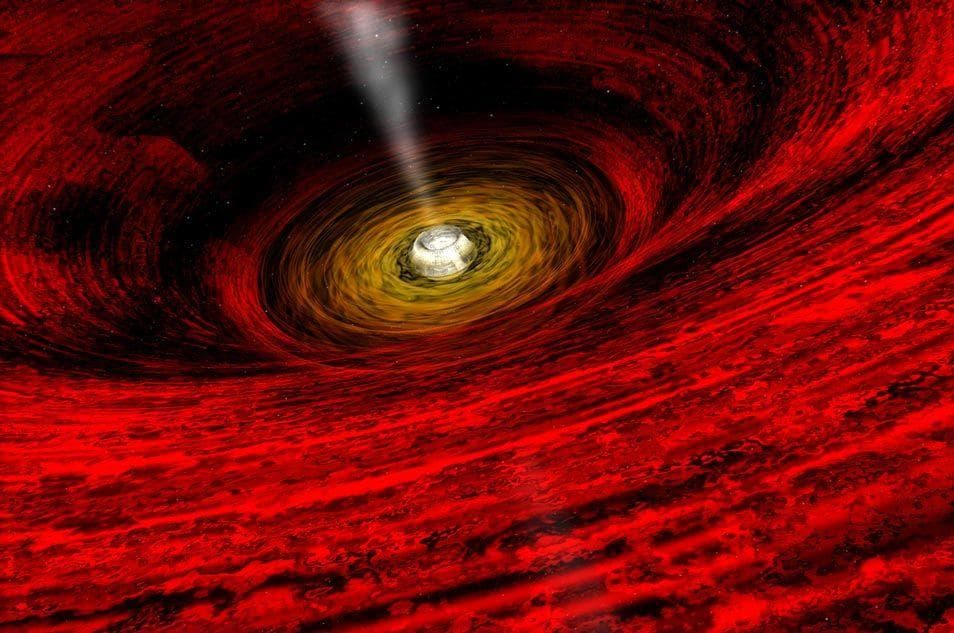-
(#1) 'Oumuamua Is The First Discovered Body From Beyond Our Solar System
One of the strangest things about 'Oumuamua is how it appeared so suddenly and without any warning; it's almost as if it was dropped into our solar system by some giant unknown hand. It's safe to say we haven't seen anything like this before.
'Oumuamua - its official name is 1I/2017 U1 - was first spotted by the University of Hawaii’s Pan-STARRS1 telescope on October 19, 2017. NASA Planetary Defense Officer Lindley Johnson said,
"We are fortunate that our sky survey telescope was looking in the right place at the right time to capture this historic moment. This serendipitous discovery is bonus science enabled by NASA’s efforts to find, track and characterize near-Earth objects that could potentially pose a threat to our planet."
-
(#2) It's Shaped Like Nothing We've Ever Seen In Space Before
'Oumuamua has been compared to a cigar or driftwood due to its strange shape. The rotating object is longer than it is wide by at least a 10:1 ratio, which is more extreme than any asteroids or comets we've ever come across. Its shape also creates dramatic changes in its surface brightness.
Dr. Karen Meech, from the Institute for Astronomy in Honolulu, HI, explains her team has come up with various theories as to why the object looks like it does;
"Sometimes very elongated objects are contact binaries... but even so, the pieces would be longer than most things in the solar system, and our analysis shows that it is rotating fast enough that they should not stay together. One of our team wondered if, during a planetary system formation, if there was a large collision between bodies that had molten cores, some material could get ejected out and then freeze in an elongated shape. Another team member was wondering if there could be some process during the ejection - say if there was a nearby supernova explosion that could be responsible."
-
(#3) 'Oumuamua Has Two Names
An object this unusual has to have a name that fits. 'Oumuamua was discovered via a University of Hawaii telescope, and its nickname is Hawaiian for "a messenger from afar arriving first." 'Oumuamua's formal name, 1I/2017 U1, has a very specific meaning.
The "I" stands for "interstellar." Objects similar to 'Oumuamua have "C" or "A" names, which places them in either comet or asteroid categories, but 'Oumuamua is so different from what we know of both, it has been given an entirely different designation.
-
(#4) Some Scientists Thought It Was A Comet
Initially, some astronomers believed 'Oumuamua was a comet, as it had qualities of one, but they were soon to discover that it didn't behave as a comet does.
Alan Fitzsimmons from the Queen's University Belfast, Northern Ireland, published a paper outlining what lead him to believe 'Oumuamua was a comet and not an asteroid. The object is made of ice - on the inside anyway.
Inevitably, the theory didn't hold water. "Given that this object passed relatively close to our sun as it was traveling, one would expect any ices on the surface to be heated. We should see gas streaming off the surface, we should see dust particles being ejected in the cometary atmosphere, perhaps even a tail," Fitzsimmons said. That never happened and scientists were left to believe it was either an asteroid or possibly an interstellar craft.
-
(#5) 'Oumuamua Also Has Traits Of An Asteroid
So, if 'Oumuamua is not a comet - at least as we know them to be - does it follow that it's an asteroid?
One of the main differences between asteroids and comets is their makeup - comets are made of ice and asteroids are composed of rock. If 'Oumuamua was a comet, it simply would have melted as it zipped past the sun, but it didn't. It was, therefore, thought of as an asteroid.
Remember the paper published by Alan Fitzsimmons and his team? It suggested that 'Oumuamua is a comet, but one with a crusty exterior. Icy interior, rocky exterior - what we have here folks, is an interstellar hybrid. Pretty cool, huh?
-
(#6) It's Covered In "Carbon Rich Gunk"
‘Oumuamua is a naturally created object with a hard exoskeleton, which took a while to form - like, it took billions of years. Scientists believe its exterior started out as ice but is now red, hard "gunk" that was probably created by interstellar radiation over time.
“The (object's) surface layer is what happens if you take comet ices and comet dust grains and bake them with high energy particles for millions or even billions of years,” said Fitzsimmons.
-
(#7) It Probably Came From A Binary Star System
Obviously, identifying the origin of the celestial "scout" is enormously tough, but there are some helpful clues helping to narrow it down a bit. Solar systems with only one star are less likely to eject waterless objects such as asteroids, unless those objects gravitationally interact with planets as massive as Saturn.
Such planets can only be found in about 10% of single star systems in this neck of the Milky Way Galaxy, so considering that roughly 75% of asteroids hurled into interstellar space come from binary systems, it's probable that 'Oumuamua originated in a system with two stars.
-
(#8) Some Astronomers Thought It Was An Alien Spacecraft
Because it's shaped the way it is, scientist wondered - could ‘Oumuamua be some kind of spacecraft? It couldn't hurt to find out. Breakthrough Listen project scientists used the Green Bank telescope in West Virginia to listen for any galactic chatter from the object.
They've only found silence, thus far and there's no evidence that ‘Oumuamua is anything more than a space rock hurling past us to some unknown destination. But they plan to keep on listening. Avi Loeb, professor of astronomy at Harvard University and an adviser to the Breakthrough Listen project, said,
“This is a fishing expedition. We are most likely not to find anything, but it is worth steadily checking our fishing hooks. We will keep searching for artificial signals from ‘Oumuamua or any other interstellar object that will be discovered in the future.”
-
(#9) It's Not Attached To Any Star System
Some scientists believe 'Oumuamua originated from Vega, Alpha Lyrae, which is about 25 light years away. However, the star would not have been in the position that it is now 300,000 years ago when 'Oumuamua started its journey toward Earth.
The object may have stumbled in that direction as it has into our solar system."'Oumuamua may well have been wandering through the Milky Way, unattached to any star system, for hundreds of millions of years before its chance encounter with this solar system," Dr. Karen Meech said.
-
(#10) ‘Oumuamua Could Have Held Life But Radiation Likely Fried It A Long Time Ago
This carbon-filled celestial Twinkie may have once held life, but, if it did, researchers think it's probably long gone by now. Alan Fitzsimmons's team at Queen's University, Belfast, believes that the ice inside the object is made from frozen methane, carbon dioxide, or methanol, and its hard shell has kept what's inside from heating up.
However, that doesn't mean anything is still alive inside. “I struggle to imagine how life could live at the frigid temperatures that would exist within a small object in interstellar space,” Fitzsimmons said.
-
(#11) How 'Oumuamua Got Here Is A Mystery
With the possibility that 'Oumuamua has been traveling through space for a very, very long time, how it came to our solar system is still - and probably always will be - a mystery. It has been theorized that it was "bumped" into our trajectory by an unknown planet.
Or, in a more likely scenario, it was ejected from an area around two stars closely orbiting each other, one of which would be affected by the gravity of the other. Either way, while it's the first interstellar traveler of its kind, it certainly won't be the last.
-
(#12) 'Oumuamua Will Zip Past Pluto By 2024
Scientists are studying 'Oumuamua while they still can. It's passing through our solar system at a pretty high rate of speed — 85,700 mph. The Atlantic's Marina Koren revealed,
"‘Oumuamua is now outside the orbit of Mars. It will pass the orbit of Jupiter next May, then Neptune in 2022, and Pluto in 2024. By 2025, it will coast beyond the outer edge of the Kuiper Belt, a field of icy and rocky objects. It will take many more years for the object to reach the Oort cloud, another region of floating objects, at the edge of the solar system."
-
(#13) 'Oumuamua May Be From The Remains Of A Massive Planet Colliding With A Red Dwarf Star
‘Oumuamua may have had a violent birth. SETI Institute scientist Matija Cuk believes the elongated object's shape gives it away in that regard. ‘Oumuamua may be the result of a distant planet - much larger than ours - getting too close to a red dwarf star and splitting apart. "Unlike the sun or Jupiter, red dwarf stars are very dense and are capable of thoroughly tidally disrupting terrestrial planets.
I conclude that the origin of 'Oumuamua as a fragment from a planet that was tidally disrupted and then ejected by a dense member of a binary system could explain its peculiarities," Cuk wrote in a paper entitled 'Oumuamua as a Tidal Disruption Fragment From a Binary Star System.
-
(#14) There Are More Interstellar Travelers Out There
It's the first we've gotten to experience, but there are many more interstellar travelers like ‘Oumuamua out there. They may have come through our solar system before, but it's only now we have the technology to spot them.
One researcher, Fabo Feng, a postdoctoral fellow from the University of Hertfordshire, believes there are "about 46m similar interstellar objects crossing the solar system every year... which may be sending us important information about how stars and planets formed."
New Random Displays Display All By Ranking
About This Tool
Astronomers have discovered a new "interstellar highway" that runs through the solar system in recent years, which can speed up the travel time of spacecraft from the earth to remote parts of the solar system in the future, and monitor and research interstellar objects that may collide with the earth. Mankind has never stopped exploring the solar system. The first exploration was carried out through telescopes.
With the advancement of science and technology, astronomers have been able to observe other interstellar objects in the solar system through high technology such as space probes. The random tool introduced amazing interstellar objects that have been caught through the solar system.
Our data comes from Ranker, If you want to participate in the ranking of items displayed on this page, please click here.










